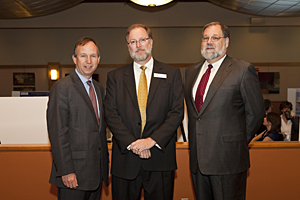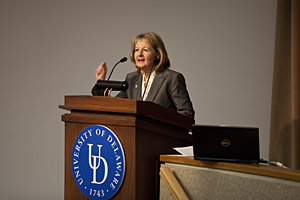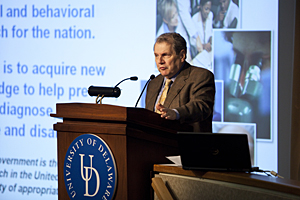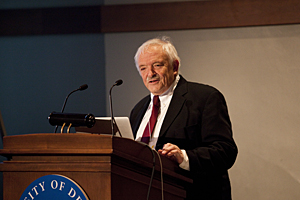



ADVERTISEMENT
- Rozovsky wins prestigious NSF Early Career Award
- UD students meet alumni, experience 'closing bell' at NYSE
- Newark Police seek assistance in identifying suspects in robbery
- Rivlin says bipartisan budget action, stronger budget rules key to reversing debt
- Stink bugs shouldn't pose problem until late summer
- Gao to honor Placido Domingo in Washington performance
- Adopt-A-Highway project keeps Lewes road clean
- WVUD's Radiothon fundraiser runs April 1-10
- W.D. Snodgrass Symposium to honor Pulitzer winner
- New guide helps cancer patients manage symptoms
- UD in the News, March 25, 2011
- For the Record, March 25, 2011
- Public opinion expert discusses world views of U.S. in Global Agenda series
- Congressional delegation, dean laud Center for Community Research and Service program
- Center for Political Communication sets symposium on politics, entertainment
- Students work to raise funds, awareness of domestic violence
- Equestrian team wins regional championship in Western riding
- Markell, Harker stress importance of agriculture to Delaware's economy
- Carol A. Ammon MBA Case Competition winners announced
- Prof presents blood-clotting studies at Gordon Research Conference
- Sexual Assault Awareness Month events, programs announced
- Stay connected with Sea Grant, CEOE e-newsletter
- A message to UD regarding the tragedy in Japan
- More News >>
- March 31-May 14: REP stages Neil Simon's 'The Good Doctor'
- April 2: Newark plans annual 'wine and dine'
- April 5: Expert perspective on U.S. health care
- April 5: Comedian Ace Guillen to visit Scrounge
- April 6, May 4: School of Nursing sponsors research lecture series
- April 6-May 4: Confucius Institute presents Chinese Film Series on Wednesdays
- April 6: IPCC's Pachauri to discuss sustainable development in DENIN Dialogue Series
- April 7: 'WVUDstock' radiothon concert announced
- April 8: English Language Institute presents 'Arts in Translation'
- April 9: Green and Healthy Living Expo planned at The Bob
- April 9: Center for Political Communication to host Onion editor
- April 10: Alumni Easter Egg-stravaganza planned
- April 11: CDS session to focus on visual assistive technologies
- April 12: T.J. Stiles to speak at UDLA annual dinner
- April 15, 16: Annual UD push lawnmower tune-up scheduled
- April 15, 16: Master Players series presents iMusic 4, China Magpie
- April 15, 16: Delaware Symphony, UD chorus to perform Mahler work
- April 18: Former NFL Coach Bill Cowher featured in UD Speaks
- April 21-24: Sesame Street Live brings Elmo and friends to The Bob
- April 30: Save the date for Ag Day 2011 at UD
- April 30: Symposium to consider 'Frontiers at the Chemistry-Biology Interface'
- April 30-May 1: Relay for Life set at Delaware Field House
- May 4: Delaware Membrane Protein Symposium announced
- May 5: Northwestern University's Leon Keer to deliver Kerr lecture
- May 7: Women's volleyball team to host second annual Spring Fling
- Through May 3: SPPA announces speakers for 10th annual lecture series
- Through May 4: Global Agenda sees U.S. through others' eyes; World Bank president to speak
- Through May 4: 'Research on Race, Ethnicity, Culture' topic of series
- Through May 9: Black American Studies announces lecture series
- Through May 11: 'Challenges in Jewish Culture' lecture series announced
- Through May 11: Area Studies research featured in speaker series
- Through June 5: 'Andy Warhol: Behind the Camera' on view in Old College Gallery
- Through July 15: 'Bodyscapes' on view at Mechanical Hall Gallery
- More What's Happening >>
- UD calendar >>
- Middle States evaluation team on campus April 5
- Phipps named HR Liaison of the Quarter
- Senior wins iPad for participating in assessment study
- April 19: Procurement Services schedules information sessions
- UD Bookstore announces spring break hours
- HealthyU Wellness Program encourages employees to 'Step into Spring'
- April 8-29: Faculty roundtable series considers student engagement
- GRE is changing; learn more at April 15 info session
- April 30: UD Evening with Blue Rocks set for employees
- Morris Library to be open 24/7 during final exams
- More Campus FYI >>
Editor's note: For a brief video highlighting Delaware Rehabilitation Institute research, click here.
11:13 a.m., Feb. 28, 2011----The Delaware Rehabilitation Institute (DRI) was officially launched on Thursday, Feb. 24, with a one-day research symposium at the University of Delaware's Clayton Hall.
According to Thomas Buchanan, DRI director and George W. Laird Professor of Mechanical Engineering, the new institute builds on a strong history of rehabilitation research and practice in Delaware, bringing together academic investigators, clinical scientists and clinicians to enable breakthrough findings to be taken from the laboratory to the clinic.
After the audience viewed a brief video highlighting several DRI research projects, Delaware Gov. Jack Markell delivered brief opening remarks. He referred to DRI as “a big deal for Delaware.”
“Cooperation is one of the things we do well in Delaware,” he said, “and it's great for me as governor to see this kind of cooperation and achievement. To see it come to life and to see the positive impact on people from little kids to world-class athletes and everyone in between -- that's what it's all about.”
Markell noted that UD has received substantial funding from the National Institutes of Health -- support that may be at risk with budget cuts. “It's important that all of us care about these kinds of investments and innovations,” he said, “and that we speak up.”
He also pointed out that there are very few centers across the country taking the holistic, comprehensive approach to rehabilitation adopted in Delaware.
Mark Barteau, senior vice provost for research and strategic initiatives at UD, said that DRI is the fourth in a series of institutes established over the past 12 years on the foundation of existing strengths at UD. The other three are the Delaware Biotechnology Institute, the UD Energy Institute and the Delaware Environmental Institute.
“With the formation of this new institute,” he said, “we've strapped another engine on the rocket that is UD's Path to ProminenceTM.”
Kathleen Matt, dean of the UD College of Health Sciences, pointed to the tremendous potential offered by a clinical and translational science institute like DRI.
“It's one thing to study mechanisms of disease,” she said, “but then what do you do with that knowledge bank? Universities have traditionally been responsible for developing the knowledge, but we are at a time when that's not enough. We need to be able to translate it into applications that will have an immediate impact.”
UD Provost Tom Apple said that UD's vision for the future of health sciences is, in many ways, aligned with the NIH Roadmap for Medical Research: To transform the way research is conducted and speed the movement of scientific discoveries from bench to bedside.
“The University of Delaware is the ideal setting for translational research, and DRI is an excellent example of how we can enhance our efforts of cross-campus research collaborations to really make a difference in people's lives,” he said. “In this living laboratory, we can shorten the time and distance from discovery to delivery. We can go from bench to bedside and back again, continually refining research, practice and technology.”
Keynotes
”The Future of Rehabilitation: A View from the NIH,” Stephen Katz, director of the National Institute of Arthritis and Muskuloskeletal and Skin Diseases (NIAMS)
One of 27 institutes making up NIH, NIAMS supports research on bone health and disease, degenerative joint disease, musculoskeletal trauma, degenerative medicine, implant science and devices. Most of the agency's other institutes also have at least some stake in rehab research, he said.
Katz shared statistics showing that musculoskeletal disorders have an impact beyond cardiovascular diseases at every age from 18 to 85+.
Also, with more soldiers' lives being saved than in previous wars, an increase in wounded warriors with traumatic limb injuries has contributed to an increase in the need for new rehab strategies and devices.
Katz provided examples of basic biology being translated to clinical medicine, including one case where improved understanding of a rare disease has led to an impact on wounded warriors.
“Rehabilitation research spans from the very molecular to the translational,” he said. “This concept of rehab medicine covering a broad spectrum from basic biology to clear translation to the patient's immediate problem is very real.”
”The Future of Rehabilitation: An RIC Perspective,” Zev Rymer, vice president for research at the Rehabilitation Institute of Chicago
Rymer said that rehabilitation research has grown significantly over the past 20 years, with funding provided by sources ranging from NIH to the Department of Education and the Department of Defense.
Successes include the development and use of evidence-based approaches, outcome assessment tools, and new engineering technologies such as advanced prostheses, robotics and diagnostic tools.
He cautioned, however, that while thousands of robotics applications and tools have been developed, robotic therapy has not proven to be as effective as originally hoped.
“But I don't think the problem is with the technologies,” Rymer said. “It's with us -- the users.” He emphasized the importance of including psychologists so that learning strategies are better understood and incorporated into future modifications of robotic devices.
“In terms of education and training, we're not really ready for the future,” Rymer said. “We're not training M.D.s to prescribe the new devices, and P.T.s and O.T.s are not prepared to use them.”
The event also included research overviews from UD faculty on stroke, osteoarthritis, childhood obesity, biomedical engineering, rehabilitation robots for infants and ACL injuries. Other sessions covered work being done by researchers at UD's partner institutions in the Delaware Health Sciences Alliance, as well as at other organizations in Delaware and beyond.
In addition, more than 20 research teams presented posters highlighting their ongoing work.
For more information about DRI, visit the website at [http://www.udel.edu/dri].
Article by Diane Kukich
Photos by Ambre Alexander


